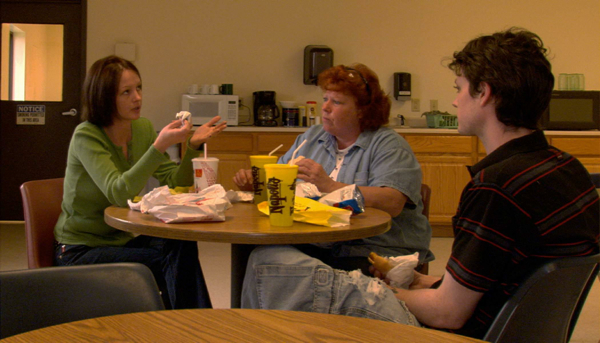Movie review by Greg Carlson
Steven Soderbergh’s “Bubble” will undoubtedly be remembered more for the circumstances surrounding its distribution than for its content or cinematic quality. Debuting simultaneously this week in theaters, on pay-per-view, and on DVD, Soderbergh seems to be offering a direct challenge to the traditional expectation of a window between theatrical run and home video release. While the movie only gathered a tepid 70K in the 32 theatres showing it, reports from the distributor claimed a total weekend return of some five million dollars. Depending on how one looks at it, this could signal the beginning of a shift in the way movies will eventually be released to the public.
Shot on high definition video – although the muddy colors, flat lighting, and frequent focus shifts look more like the results of consumer-grade tape – “Bubble” is purportedly going to be the first of six low-budget properties that will see the same type of opening day simultaneity. Soderbergh is no stranger to innovative, do-it-yourself moviemaking, and he has maintained an aggressive, if not always successful, blend of lavish projects (“Ocean’s Eleven”) and edgier pursuits (“Full Frontal”). Along with directing “Bubble,” Soderbergh also shot and edited, employing pseudonyms for those tasks.
Working from a lightly-sketched screenplay by Coleman Hough, Soderbergh comments on the emptiness and banality of low-income life in a small town on the Ohio-West Virginia border. Set in a doll factory, which affords ample opportunity for unsettling shots of the grotesque and fascinating process of assembling tiny imitations of babies, “Bubble” focuses on the relationship between middle-aged Martha (Debbie Doebereiner) and quiet Kyle (Dustin James Ashley). None of the principal performers in the movie are professional actors, and the casting choices bring a layer of documentary-like realism to the movie that suggests a purposefully designed minimalism.
An uneasy triangle forms when pretty, single mother Rose (Misty Dawn Wilkins) is hired at the factory. An immediate threat to the comfortable friendship of Martha and Kyle, Rose’s arrival injects some tension into the movie, especially when it is revealed that there is more to her than either Kyle or Martha first guesses. A shocking murder is committed less than one hour into the movie’s very brief running time, and the final section delivers an absorbing investigation that showcases Soderbergh’s near-obsessive sense of restraint. Decker Moody, as the police detective who interviews the people involved with the crime, is ideally suited for his role.
Given the reception of “Bubble,” one would assume that viewers would opt to stay home for a movie rather than go out to see it if the choice is offered. While the cost of a new DVD, even discounted, totals more than the price of a movie ticket, consumers might enjoy the freedom of being able to start, stop, and replay the movie – especially in the comfort of a well-appointed home theater. The “Bubble” DVD also includes two audio commentaries, a deleted scene with an alternate ending that provides information that significantly alters the version shown in theaters, and some additional content covering the lives of the actors and the casting process. Having immediate access to this material changes the experience of “Bubble,” enhancing its value.
